The bioprocess fermentation monitoring market is projected to grow from USD 1,635.7 million in 2025 to approximately USD 3,434.5 million by 2035, recording an absolute increase of USD 1,798.8 million over the forecast period. This translates into a total growth of 110%, with the market forecast to expand at a compound annual growth rate (CAGR) of 7.7% between 2025 and 2035.
The overall market size is expected to grow by 2.1X during the same period, supported by increasing demand for advanced bioprocessing technologies, growing adoption of automated monitoring systems, and rising focus on process optimization across biotechnology, pharmaceutical, and food & beverage industries worldwide.
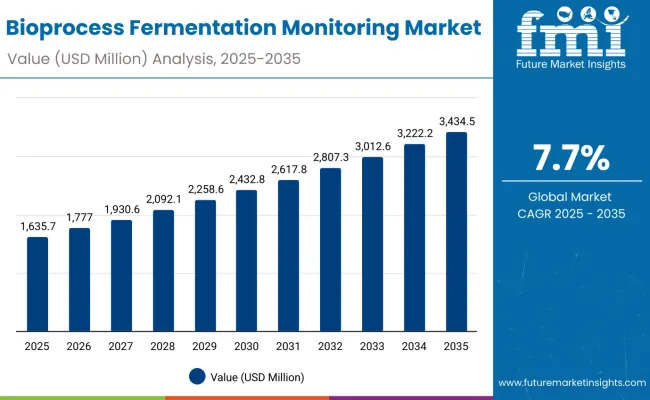
Bioprocess Fermentation Monitoring Market Key Takeaways
| Metric | Value |
|---|---|
| Estimated Value in (2025E) | USD 1,635.7 million |
| Forecast Value in (2035F) | USD 3,434.5 million |
| Forecast CAGR (2025 to 2035) | 7.7% |
Between 2025 and 2030, the bioprocess fermentation monitoring market is projected to expand from USD 1,635.7 million to USD 2,370.2 million, resulting in a value increase of USD 734.5 million, which represents 40.8% of the total forecast growth for the decade. This phase of development will be shaped by increasing adoption of real-time monitoring solutions, growing demand for process analytical technology (PAT), and expanding applications in biopharmaceutical manufacturing. Biotechnology companies and process equipment manufacturers are enhancing their monitoring capabilities to address the growing need for precise fermentation control and optimization.
From 2030 to 2035, the market is forecast to grow from USD 2,370.2 million to USD 3,434.5 million, adding another USD 1,064.3 million, which constitutes 59.2% of the overall ten-year expansion. This period is expected to be characterized by the expansion of advanced sensor technologies, integration of artificial intelligence and machine learning algorithms for predictive analytics, and development of comprehensive digital bioprocessing platforms. The growing emphasis on continuous manufacturing and process intensification will drive demand for sophisticated monitoring systems with enhanced data analytics capabilities and improved process control features.
Between 2020 and 2024, the bioprocess fermentation monitoring market experienced steady growth, driven by increasing biopharmaceutical production, growing awareness of process optimization benefits, and rising adoption of automated monitoring systems across biotechnology and pharmaceutical manufacturing facilities. The market developed as industry players recognized the potential for advanced monitoring technology to enhance product quality, reduce production costs, and ensure regulatory compliance. Technological advancement in sensor design and data analytics began emphasizing the critical importance of real-time process understanding while improving manufacturing efficiency and product consistency.
The bioprocess fermentation monitoring market represents a rapidly expanding technology opportunity at the intersection of biotechnology, process automation, and data analytics, with the market projected to expand from USD 1,635.7 million in 2025 to USD 3,434.5 million by 2035 at a robust 7.7% CAGR a 2.1X growth driven by accelerating biopharmaceutical production, increasing demand for process optimization solutions, and the integration of advanced sensor technologies into bioprocessing operations.
This convergence opportunity leverages the growing need for quality control, the desire for process efficiency improvement, and advances in sensor technology to create solutions that offer real-time monitoring capabilities with enhanced data analytics features. In-line fermentation monitors lead with 65.4% market share due to their ability to provide continuous monitoring without sampling interruption, while food & beverage applications dominate demand as manufacturers increasingly focus on process optimization and quality assurance. Geographic growth is strongest in developed markets where advanced bioprocessing infrastructure and regulatory requirements support adoption of sophisticated monitoring systems.
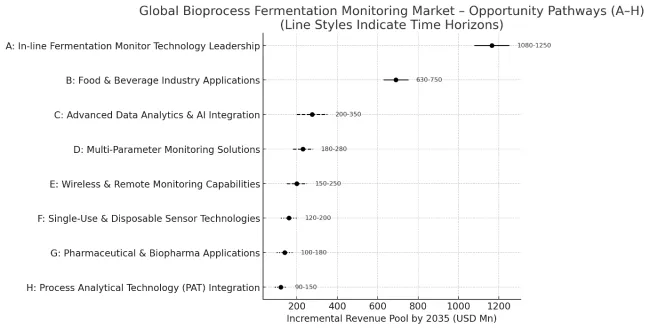
Pathway A - In-line Fermentation Monitor Technology Leadership
The dominant product category offers superior real-time monitoring capabilities, continuous data collection, and minimized contamination risk essential for critical bioprocess applications. Companies developing advanced in-line monitoring systems with enhanced sensor accuracy, improved data integration, and extended operational life will capture the leading technology segment. Expected revenue pool: USD 1,080-1,250 million.
Pathway B - Food & Beverage Industry Applications
The largest application segment benefits from growing focus on process consistency, quality assurance, and production efficiency in food and beverage manufacturing. Providers developing comprehensive monitoring solutions with industry-specific features, regulatory compliance support, and cost-effective implementation will dominate this primary market. Opportunity: USD 630-750 million.
Pathway C - Advanced Data Analytics and AI Integration
Next-generation products require sophisticated data processing capabilities for predictive analytics, process optimization, and automated control systems. Companies investing in machine learning algorithms, cloud-based analytics platforms, and automated decision-making capabilities will create competitive differentiation and premium positioning. Revenue uplift: USD 200-350 million.
Pathway D - Multi-Parameter Monitoring Solutions
Modern bioprocesses require simultaneous monitoring of multiple critical parameters including pH, dissolved oxygen, temperature, and biomass concentration. Developing integrated monitoring platforms with comprehensive parameter coverage addresses growing demand for holistic process understanding while reducing system complexity. Expected upside: USD 180-280 million.
Pathway E - Wireless and Remote Monitoring Capabilities
Advanced products require seamless connectivity with plant control systems, laboratory information management systems, and cloud-based analytics platforms. Systems offering comprehensive wireless connectivity, remote monitoring capabilities, and mobile access create enhanced value propositions for process engineers and plant operators. USD 150-250 million.
Pathway F - Single-Use and Disposable Sensor Technologies
Biopharmaceutical manufacturers require contamination-free monitoring solutions that eliminate cross-contamination risks and reduce cleaning validation requirements. Companies developing advanced single-use sensor technologies with reliable performance and cost-effective implementation will capture premium positioning opportunities. Pool: USD 120-200 million.
Pathway G - Pharmaceutical and Biopharmaceutical Applications
High-value therapeutic manufacturing requires precise process control and regulatory compliance support for critical quality attributes. Developing specialized solutions for cell culture monitoring, vaccine production, and biologics manufacturing expands beyond standard food industry applications. Expected revenue: USD 100-180 million.
Pathway H - Process Analytical Technology (PAT) Integration
Regulatory requirements drive demand for solutions that support Quality by Design (QbD) principles and continuous process verification. Companies developing comprehensive PAT platforms with real-time release testing capabilities and regulatory documentation support will capture emerging market opportunities. Pool: USD 90-150 million.
Market expansion is being supported by the increasing global demand for biopharmaceutical products and the corresponding shift toward advanced bioprocessing technologies that can provide superior process control while meeting regulatory requirements for quality assurance and manufacturing efficiency. Modern biotechnology companies and pharmaceutical manufacturers are increasingly focused on incorporating sophisticated fermentation monitoring systems to enhance product quality while satisfying demands for cost-effective production and regulatory compliance.
Bioprocess fermentation monitoring systems' proven ability to deliver superior process understanding, real-time data collection, and automated control capabilities makes them essential technologies for biopharmaceutical manufacturing and food processing applications.
The growing emphasis on process analytical technology (PAT) and continuous manufacturing approaches is driving demand for high-quality fermentation monitoring products that can support distinctive process optimization and comprehensive quality control across biopharmaceutical production, food & beverage manufacturing, and research laboratory categories. Industry preference for systems that combine real-time monitoring excellence with data analytics capabilities is creating opportunities for innovative monitoring implementations in both large-scale manufacturing and pilot plant applications. The rising influence of digital bioprocessing and Industry 4.0 concepts is also contributing to increased adoption of advanced fermentation monitoring products that can provide authentic process intelligence characteristics.
The market is segmented by product type and end user. The demand for products is divided into in-line fermentation monitors, off-line fermentation monitors, and others. Based on end user, the market is categorized into food & beverage, pharmaceuticals & biopharma, research laboratories, and others.
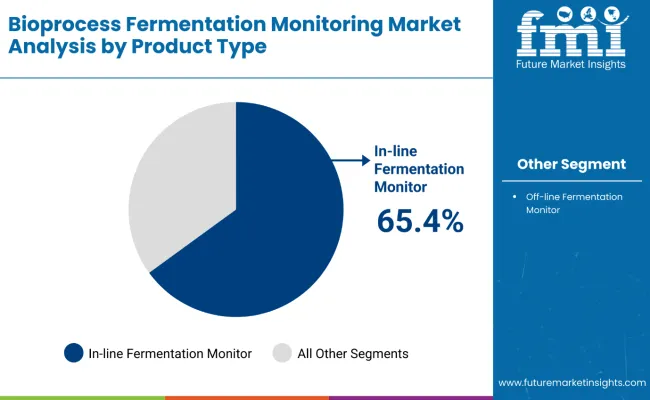
The in-line fermentation monitors segment is projected to account for 65.4% of the bioprocess fermentation monitoring market in 2025, strengthening to 66.1% by 2035, reaffirming its position as the leading product category. Bioprocessing companies and manufacturing facilities increasingly utilize in-line fermentation monitoring technology for their superior real-time monitoring capabilities, continuous data collection features, and ability to minimize sampling contamination in critical bioprocess applications across diverse industrial settings. In-line monitoring technology's advanced sensor design and proven performance directly address the operational requirements for consistent process control and reliable data generation in fermentation operations.
This product segment forms the foundation of modern bioprocessing applications, as it represents the technology with the greatest automation potential and established compatibility across multiple manufacturing systems. Manufacturer investments in sensor optimization and data integration continue to strengthen adoption among process equipment producers. With industry players prioritizing process efficiency and data quality, in-line fermentation monitoring systems align with both operational excellence objectives and regulatory compliance requirements, making them the central component of comprehensive bioprocessing strategies.
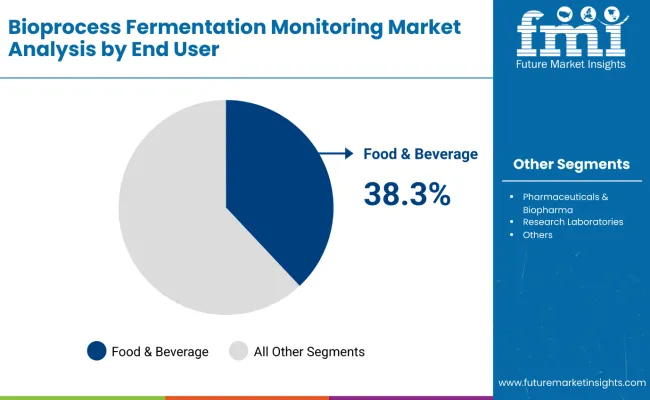
Food & beverage applications are projected to represent the largest share of bioprocess fermentation monitoring demand in 2025 at 38.3%, maintaining leadership at 38.5% by 2035, underscoring their critical role as the primary application for advanced monitoring systems in food production, beverage manufacturing, and quality assurance protocols. Food and beverage manufacturers prefer fermentation monitoring systems for their exceptional process control capabilities, quality consistency features, and ability to maintain product specifications while supporting production efficiency requirements during large-scale manufacturing operations. Positioned as essential technologies for food safety and quality management, fermentation monitoring systems offer both process optimization and regulatory compliance advantages.
The segment is supported by continuous growth in food processing automation and the growing availability of advanced monitoring technologies that enable enhanced product quality and cost reduction at the manufacturing level. Additionally, food companies are investing in process optimization technologies to support product consistency improvement and operational efficiency enhancement. As food safety regulations continue to evolve and manufacturers seek superior quality control solutions, food & beverage applications will continue to dominate the end user landscape while supporting technology advancement and manufacturing optimization strategies.
The bioprocess fermentation monitoring market is advancing steadily due to increasing biopharmaceutical production volumes and growing demand for process analytical technology solutions that emphasize superior quality control across manufacturing scale-up and commercial production applications. However, the market faces challenges, including high initial investment costs compared to traditional monitoring methods, technical complexity in multi-parameter integration, and competition from established process control systems. Innovation in sensor technology advancement and data analytics enhancement continues to influence market development and expansion patterns.
Expansion of Biopharmaceutical Manufacturing Capabilities
The growing adoption of fermentation monitoring systems in comprehensive biopharmaceutical production and therapeutic manufacturing applications is enabling biotechnology companies to develop processes that provide distinctive quality assurance capabilities while commanding premium positioning and enhanced product quality characteristics. Advanced monitoring protocols provide superior control while allowing more sophisticated process optimization across various manufacturing scales and production segments. Manufacturing facilities are increasingly recognizing the competitive advantages of real-time monitoring positioning for comprehensive quality management development and biotechnology market penetration.
Integration of Advanced Sensor Technology and Digital Analytics
Modern fermentation monitoring system suppliers are incorporating advanced multi-parameter sensors, wireless data transmission capabilities, and cloud-based analytics platforms to enhance monitoring accuracy, improve process understanding, and meet manufacturer demands for intelligent and reliable bioprocess control solutions. These programs improve system performance while enabling new applications, including predictive process control and automated optimization systems. Advanced digital integration also allows suppliers to support premium market positioning and operational excellence leadership beyond traditional monitoring products.
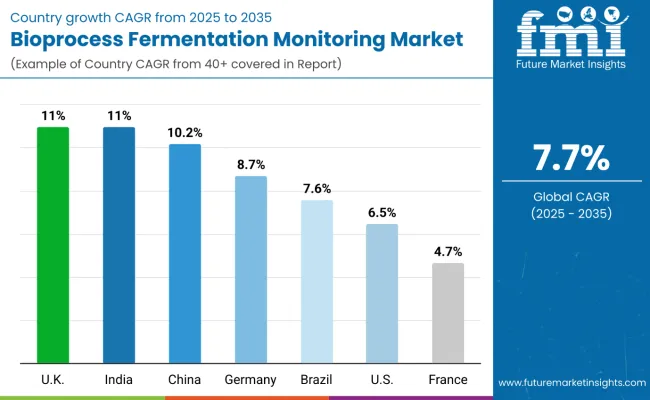
| Countries | CAGR (2025 to 2035) |
|---|---|
| India | 11.0% |
| China | 10.2% |
| Germany | 8.7% |
| Brazil | 7.6% |
| UK | 11.0% |
| USA | 6.5% |
| France | 4.7% |
The bioprocess fermentation monitoring market is experiencing robust growth globally, with India and the UK leading at an 11.0% CAGR through 2035, driven by expanding biotechnology sectors, rising pharmaceutical manufacturing, and increasing adoption of advanced process monitoring technologies. China follows at 10.2%, supported by growing biopharmaceutical investments, expanding manufacturing capabilities, and rising focus on process optimization.
Germany shows growth at 8.7%, emphasizing precision engineering and advanced manufacturing technology integration. Brazil demonstrates 7.6% growth, prioritizing biotechnology development and pharmaceutical manufacturing expansion. The USA records 6.5%, focusing on biopharmaceutical innovation and advanced process control solutions. France exhibits 4.7% growth, supported by established pharmaceutical infrastructure and technology adoption initiatives.
The report covers an in-depth analysis of 40+ countries; seven top-performing countries are highlighted below.
Revenue from bioprocess fermentation monitoring in India is projected to exhibit exceptional growth with a CAGR of 11.0% through 2035, driven by expanding biotechnology infrastructure and rising pharmaceutical manufacturing capabilities across major industrial and research centers. The country's growing biopharmaceutical sector and increasing adoption of advanced process monitoring technologies are creating substantial demand for fermentation monitoring solutions in both domestic manufacturing and export-oriented production facilities. Major biotechnology companies and process equipment manufacturers are establishing comprehensive distribution and technical support capabilities to serve both local market needs and regional manufacturing requirements.
Revenue from bioprocess fermentation monitoring in China is expanding at a CAGR of 10.2%, supported by growing biopharmaceutical investments, increasing manufacturing capabilities, and expanding biotechnology infrastructure with advanced monitoring capabilities. The country's developing bioprocessing ecosystem and expanding pharmaceutical manufacturing sector are driving demand for sophisticated fermentation monitoring products across both established production facilities and emerging biotechnology centers. International process equipment companies and domestic manufacturing suppliers are establishing comprehensive production and technical support capabilities to address growing market demand for advanced monitoring solutions.
Revenue from bioprocess fermentation monitoring in Germany is projected to grow at a CAGR of 8.7% through 2035, driven by precision engineering excellence, advanced manufacturing capabilities, and established expertise in process control requiring sophisticated monitoring solutions. Germany's leading process equipment sector and increasing emphasis on Industry 4.0 integration are creating substantial demand for both standard and premium fermentation monitoring varieties. Leading process equipment companies and biotechnology specialists are establishing comprehensive manufacturing strategies to serve both German markets and growing international demand.
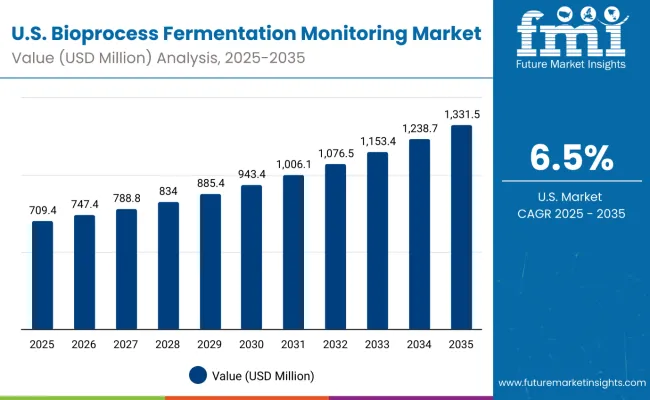
Revenue from bioprocess fermentation monitoring in the United States is projected to grow at a CAGR of 6.5% through 2035, supported by the country's advanced biopharmaceutical sector, innovation leadership capabilities, and established market for sophisticated process control solutions. American biotechnology companies and pharmaceutical manufacturers prioritize process excellence, regulatory compliance, and technological advancement, making fermentation monitoring systems essential technologies for both commercial manufacturing and research development applications. The country's comprehensive biotechnology ecosystem and regulatory adoption patterns support continued market development.
Revenue from bioprocess fermentation monitoring in France is projected to grow at a CAGR of 4.7% through 2035, supported by the country's pharmaceutical infrastructure development, established biotechnology sector, and proven expertise in process control applications. French pharmaceutical manufacturers' focus on quality excellence, regulatory compliance, and technological innovation creates steady demand for reliable monitoring products. The country's attention to manufacturing quality and process control drives consistent adoption across both traditional pharmaceutical and emerging biotechnology applications.
Revenue from bioprocess fermentation monitoring in the United Kingdom is projected to grow at a CAGR of 11.0% through 2035, supported by the country's biotechnology innovation priorities, advanced pharmaceutical development sector, and established focus on process optimization and manufacturing excellence. British biotechnology companies' emphasis on innovation, quality outcomes, and regulatory compliance creates strong demand for advanced monitoring products. The country's attention to biotechnology advancement and manufacturing efficiency drives consistent adoption across both established pharmaceutical and emerging biotech applications.
Revenue from bioprocess fermentation monitoring in Brazil is projected to grow at a CAGR of 7.6% through 2035, supported by the country's biotechnology development initiatives, expanding pharmaceutical manufacturing sector, and growing focus on process optimization while working to enhance manufacturing capabilities and develop cost-effective production technologies. Brazil's biotechnology industry continues to benefit from government support while focusing on manufacturing advancement and technology adoption.
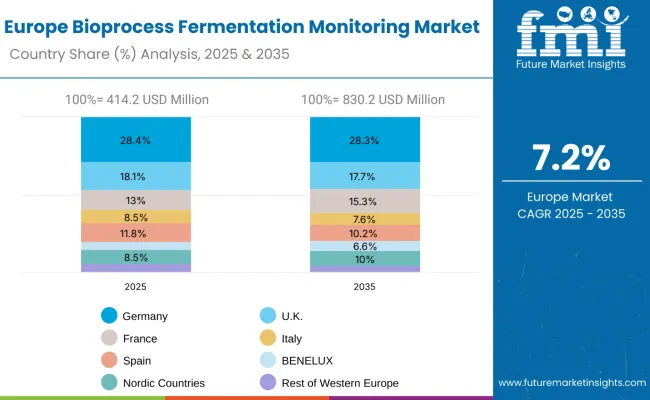
The bioprocess fermentation monitoring market in Europe is projected to grow at a CAGR of 7.2% from 2025 to 2035. Germany is expected to maintain its leadership position with a 28.4% market share in 2025, declining slightly to 28.3% by 2035, supported by its precision engineering sector, advanced manufacturing infrastructure, and process control capabilities serving regional and international markets.
The United Kingdom follows with a 18.1% share in 2025, projected to decline to 17.7% by 2035, driven by priorities in advanced biotechnology, process innovation, and pharmaceutical manufacturing excellence. France holds a 13.0% share in 2025, expected to increase to 15.3% by 2035, supported by pharmaceutical infrastructure development and process technology adoption, benefiting from strategic positioning and regulatory advantages.
Italy accounts for 8.5% in 2025, projected to ease to 7.6% by 2035, while Spain contributes 11.8% in 2025, declining to 10.2% by 2035. The BENELUX region represents 5.7% in 2025, shifting to 6.6% in 2035, while Nordic Countries hold 8.5% in 2025, increasing to 10.0% by 2035. The Rest of Western Europe region is expected to account for 6.1% in 2025, moderating to 4.3% by 2035, reflecting mixed growth dynamics across smaller and mature markets.
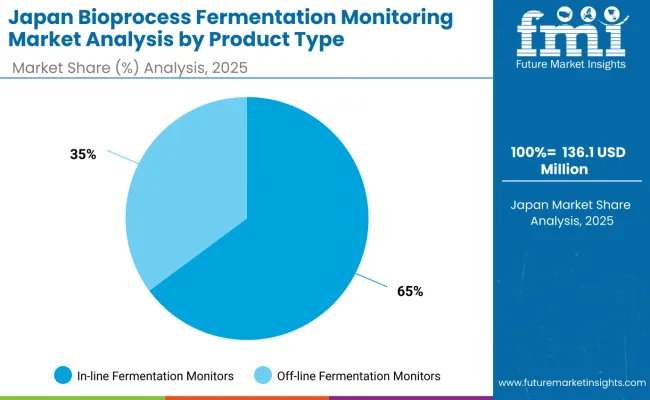
The bioprocess fermentation monitoring market in Japan is projected to grow steadily from 2025 to 2035, supported by advanced manufacturing infrastructure, strong biotechnology ecosystem, and adoption of precision monitoring technologies.
In-line fermentation monitors are expected to maintain their leadership position with a 62.7% market share in 2025, projected to remain dominant through 2035, reflecting strong demand for continuous monitoring capabilities and automated process control. Off-line fermentation monitors follow with 37.3% in 2025, supported by established laboratory practices and specialized analytical requirements in pharmaceutical and research applications.
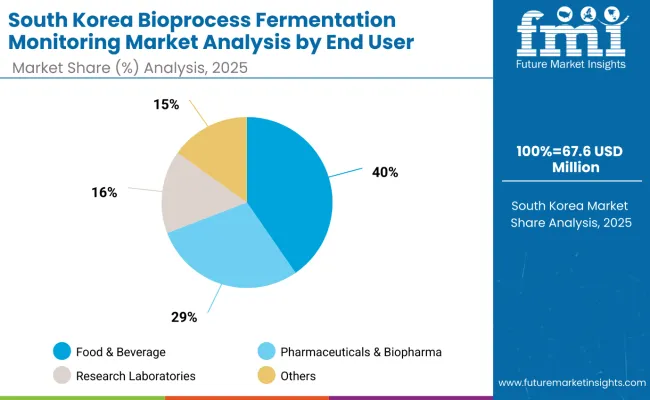
The bioprocess fermentation monitoring market in South Korea is projected to expand through 2035, driven by rapid biotechnology adoption, strong pharmaceutical manufacturing growth, and increasing focus on process optimization.
Food & beverage is expected to maintain its leadership with a 40.4% market share, supported by expanding food processing industry and growing emphasis on quality control in manufacturing operations. Pharmaceuticals & biopharma follow closely with 28.8%, reflecting South Korea's growing pharmaceutical sector and biotechnology advancement initiatives.
Research laboratories account for 15.7%, supported by strong academic research programs and government investment in biotechnology development. Others represent 15.1%, encompassing emerging applications and specialized industrial uses.
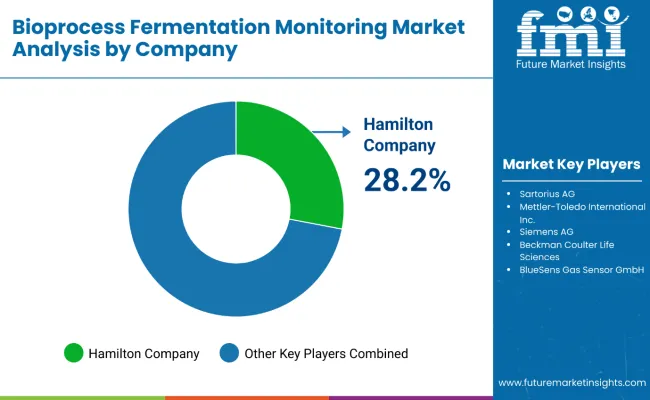
The bioprocess fermentation monitoring market is characterized by competition among established process equipment companies, specialized biotechnology suppliers, and integrated automation technology providers. Companies are investing in advanced sensor technologies, data analytics capabilities, application-specific product development, and comprehensive technical support services to deliver consistent, high-performance, and reliable monitoring solutions. Innovation in multi-parameter monitoring, wireless connectivity enhancement, and customized application compatibility is central to strengthening market position and customer satisfaction.
Hamilton Company leads the market with a 28.2% share, focusing on comprehensive bioprocess solutions and advanced sensor technologies, offering premium fermentation monitoring products with emphasis on accuracy, reliability, and process integration capabilities. Other key players (71.8% combined) provide specialized monitoring and process control capabilities with focus on innovation and technical support. Sartorius AG delivers integrated bioprocessing solutions with emphasis on single-use technologies and process optimization.
Mettler-Toledo International Inc. specializes in precision measurement technologies with focus on sensor accuracy and data quality. Siemens AG focuses on automation and digitalization with emphasis on process integration and smart manufacturing capabilities. Beckman Coulter Life Sciences provides laboratory and process analytical solutions, while BlueSens Gas Sensor GmbH specializes in advanced gas sensing technologies for bioprocess applications.
| Items | Values |
|---|---|
| Quantitative Units (2025) | USD 1,635.7 million |
| Product Type | In-line Fermentation Monitors, Off-line Fermentation Monitors, Others |
| End User | Food & Beverage, Pharmaceuticals & Biopharma, Research Laboratories, Others |
| Regions Covered | North America, Europe, East Asia, South Asia & Pacific, Latin America, Middle East & Africa |
| Countries Covered | United States, Canada, United Kingdom, Germany, France, China, Japan, South Korea, India, Brazil, Australia and 40+ countries |
| Key Companies Profiled | Hamilton Company, Sartorius AG, Mettler-Toledo International Inc., Siemens AG, Beckman Coulter Life Sciences, BlueSens Gas Sensor GmbH |
| Additional Attributes | Dollar sales by product type and end user, regional demand trends, competitive landscape, technological advancements in bioprocess monitoring, industry integration initiatives, process optimization programs, and quality enhancement strategies |
By North America
By Europe
By East Asia
By South Asia & Pacific
By Latin America
By Middle East & Africa
The global bioprocess fermentation monitoring market is valued at USD 1,635.7 million in 2025.
The size for the bioprocess fermentation monitoring market is projected to reach USD 3,434.5 million by 2035.
The bioprocess fermentation monitoring market is expected to grow at a 7.7% CAGR between 2025 and 2035.
The key product type segments in the bioprocess fermentation monitoring market are in-line fermentation monitors, off-line fermentation monitors, and others.
In terms of end user, food & beverage segment is set to command 38.3% share in the bioprocess fermentation monitoring market in 2025.






Our Research Products

The "Full Research Suite" delivers actionable market intel, deep dives on markets or technologies, so clients act faster, cut risk, and unlock growth.

The Leaderboard benchmarks and ranks top vendors, classifying them as Established Leaders, Leading Challengers, or Disruptors & Challengers.

Locates where complements amplify value and substitutes erode it, forecasting net impact by horizon

We deliver granular, decision-grade intel: market sizing, 5-year forecasts, pricing, adoption, usage, revenue, and operational KPIs—plus competitor tracking, regulation, and value chains—across 60 countries broadly.

Spot the shifts before they hit your P&L. We track inflection points, adoption curves, pricing moves, and ecosystem plays to show where demand is heading, why it is changing, and what to do next across high-growth markets and disruptive tech

Real-time reads of user behavior. We track shifting priorities, perceptions of today’s and next-gen services, and provider experience, then pace how fast tech moves from trial to adoption, blending buyer, consumer, and channel inputs with social signals (#WhySwitch, #UX).

Partner with our analyst team to build a custom report designed around your business priorities. From analysing market trends to assessing competitors or crafting bespoke datasets, we tailor insights to your needs.
Supplier Intelligence
Discovery & Profiling
Capacity & Footprint
Performance & Risk
Compliance & Governance
Commercial Readiness
Who Supplies Whom
Scorecards & Shortlists
Playbooks & Docs
Category Intelligence
Definition & Scope
Demand & Use Cases
Cost Drivers
Market Structure
Supply Chain Map
Trade & Policy
Operating Norms
Deliverables
Buyer Intelligence
Account Basics
Spend & Scope
Procurement Model
Vendor Requirements
Terms & Policies
Entry Strategy
Pain Points & Triggers
Outputs
Pricing Analysis
Benchmarks
Trends
Should-Cost
Indexation
Landed Cost
Commercial Terms
Deliverables
Brand Analysis
Positioning & Value Prop
Share & Presence
Customer Evidence
Go-to-Market
Digital & Reputation
Compliance & Trust
KPIs & Gaps
Outputs
Full Research Suite comprises of:
Market outlook & trends analysis
Interviews & case studies
Strategic recommendations
Vendor profiles & capabilities analysis
5-year forecasts
8 regions and 60+ country-level data splits
Market segment data splits
12 months of continuous data updates
DELIVERED AS:
PDF EXCEL ONLINE
Bioprocess Technology Market Size and Share Forecast Outlook 2025 to 2035
Bioprocessing Analytics Equipment Market Size and Share Forecast Outlook 2025 to 2035
Bioprocessing Supplies Market Size and Share Forecast Outlook 2025 to 2035
Bioprocess Integrity Testing Systems Market Size and Share Forecast Outlook 2025 to 2035
Bioprocess Validation Market Analysis by Testing Type, Stage, Mode, and Region through 2035
Bioprocess Containers & Fluid Transfer Solutions Market – Trends & Forecast 2025 to 2035
Bioprocessing Systems Market
Portable Bioprocessing Bioreactors Market Size and Share Forecast Outlook 2025 to 2035
Upstream Bioprocessing Equipment Market - Growth, Trends & Forecast 2025 to 2035
Real-time Bioprocess Raman Analyzer Market Analysis - Size, Share, and Forecast Outlook 2025 to 2035
Single-use Bioprocessing Probes and Sensors Market - Growth & Trends 2024 to 2034
Fermentation Chemicals Market Size and Share Forecast Outlook 2025 to 2035
Fermentation Equipment Market Size and Share Forecast Outlook 2025 to 2035
Fermentation Defoamer Market Size and Share Forecast Outlook 2025 to 2035
Assessing Fermentation Chemicals Market Share & Industry Trends
Fish Fermentation Market Size and Share Forecast Outlook 2025 to 2035
Wine Fermentation Equipment Market Size and Share Forecast Outlook 2025 to 2035
Precision Fermentation Ingredients Market Size and Share Forecast Outlook 2025 to 2035
Probiotic Fermentation Skincare Market Size and Share Forecast Outlook 2025 to 2035
Microbial Fermentation Technology Market Size and Share Forecast Outlook 2025 to 2035

Thank you!
You will receive an email from our Business Development Manager. Please be sure to check your SPAM/JUNK folder too.
Chat With
MaRIA